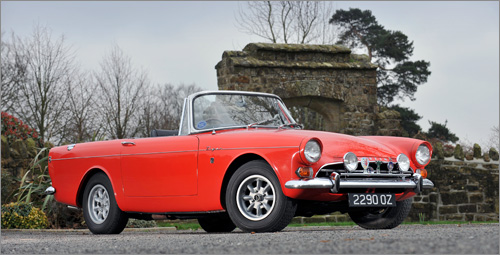Inspired by Carroll Shelby’s success in shoehorning a Ford V8 into the AC Ace to create the Cobra, British carmaker Rootes asked Shelby to perform the same trick with its Sunbeam Alpine sports car. Ford’s 260-ci V8 engine was chosen, and even though this had “only”160 horsepower on tap, its power was nearly double the output of the contemporary Alpine’s 1.6-liter engine.
Assembled by Jensen Motors and introduced in 1964, the Tiger featured a stronger gearbox and rear axle—plus rack-and-pinion steering. Vastly superior to its Alpine progenitor in performance terms, the Tiger stormed to 60 mph in under ten seconds and peaked at 117 mph. Sadly, the model was killed off by Rootes’ new owner—Chrysler—shortly after the Tiger II was introduced in 1967.
This example was delivered new on July 17, 1965, from A. S. Baird Ltd to a Mr. J. Dowling of Belfast, Northern Ireland (the original purchase invoice is on file). Also included in the file is an old-style logbook and a photocopy of the Swansea V5C registration document showing three previous owners, the last being a Ms. J Cochrane. Other documentation includes six old tax discs and three MoTs from Northern Ireland, the most recent of which was issued at 21,471 miles and expired on February 6, 2010.
In the history file also are assorted press cuttings about the car in Northern Ireland; a factory-produced leaflet called The Tale of the Tiger; an AA road test report on the Sunbeam Tiger; an original owner’s service book; and a manufacturer’s warranty book issued by the Rootes Group. Representing a rare opportunity to acquire one of these charismatic Anglo-American sports cars, 2290OZ comes with Swansea V5 document, MoT to June 2, 2010 (issued at 22,315 miles), and factory hard top.
Assembled by Jensen Motors and introduced in 1964, the Tiger featured a stronger gearbox and rear axle—plus rack-and-pinion steering. Vastly superior to its Alpine progenitor in performance terms, the Tiger stormed to 60 mph in under ten seconds and peaked at 117 mph. Sadly, the model was killed off by Rootes’ new owner—Chrysler—shortly after the Tiger II was introduced in 1967.
This example was delivered new on July 17, 1965, from A. S. Baird Ltd to a Mr. J. Dowling of Belfast, Northern Ireland (the original purchase invoice is on file). Also included in the file is an old-style logbook and a photocopy of the Swansea V5C registration document showing three previous owners, the last being a Ms. J Cochrane. Other documentation includes six old tax discs and three MoTs from Northern Ireland, the most recent of which was issued at 21,471 miles and expired on February 6, 2010.
In the history file also are assorted press cuttings about the car in Northern Ireland; a factory-produced leaflet called The Tale of the Tiger; an AA road test report on the Sunbeam Tiger; an original owner’s service book; and a manufacturer’s warranty book issued by the Rootes Group. Representing a rare opportunity to acquire one of these charismatic Anglo-American sports cars, 2290OZ comes with Swansea V5 document, MoT to June 2, 2010 (issued at 22,315 miles), and factory hard top.

